15 November 2009
japanese writings
19/11/09 14:01 Filed in: Food and Travel
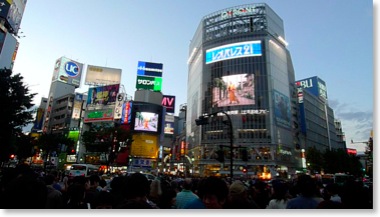
What better place to find yourself on a stopover or longer than the most exciting city in the world: Tokyo, a food lovers dream! There are about 5,000 restaurants in London, 15,000 in New York, but Tokyo boasts 88,000 and still counting. It is a nation obsessed by food, so every type of cuisine can be found here; some of the best Italian dining is to be had in Tokyo, cooked by Japanese chefs. There has been a long history of Japanese chefs working in Michelin restaurants in France and returning to open their own.
Finally Michelin has come to town and sprinkled stars generously and they still have not scratched the surface, there are many that will stay hidden for the private clients where just getting a booking requires an introduction.This is what makes this city special dedication to the culinary art and only sharing with the cognoscenti.
Believe me there is plenty of choice without needing a bottomless wallet and a network of those in the know!
The French and British super chefs are making inroads into Tokyo. Robluchon has his second Artelier here, Pierre Gagnaire has opened recently, Gordon Ramsey has made a showing with two restaurants at the Conrad hotel and Alain Ducasse with Beige is receiving its first plaudits .
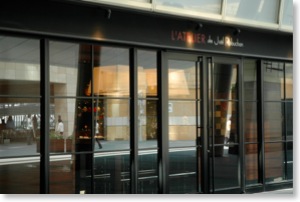
Here can be found hotels in abundance from capsule to the highest in luxury; service is exemplary and tipping is definitely frowned upon.
A subway system that is efficient, clean and vast; Shinjuku station moves over 2 million people a day. It is quite interesting to be listening to music on you iPod, something serene. Just find a spot and watch the mass of rushing humanity, quite an ethereal experience.
Accommodation
Tokyo, known for the stratospheric price of its real estate, deals with it the same way as New York; they build high, and as for hotel rooms they tend to be smaller than their European counterparts. Nonetheless accommodation can be reasonable. You could stay close to the Ginza and within walking distance of Tsukiji market for about ¥8,000 in a business hotel, not big on glamour but more than adequate; perhaps a family run ryokan in the old part of town near Asakusa Kannon temple, with a roof top ofuro (bath) with views over the roofs and temples of Tokyo .
If you would like to relive moments of ‘lost in translation’, the Park Hyatt would be your destination, late at night with a scotch, sat at the bar overlooking the sea of neon.
The love hotels of Tokyo for those who like a room with a difference. To explain: the Japanese live in close proximity to each other, many living with their parents or they are just dating and there is nowhere for privacy, so you can rent a room by the hour, some with wild themes: spacecraft, funfairs, vibrating beds, jacuzzis. These are seldom used overnight, so turning up late and getting a cheap room is always possible.
And finally something so Japanese: the capsule hotel, cheap but not for the claustrophobic, they have a communal washing facility much like an onsen, but these hotels are single sex generally and are geared to the salary man who is usually too drunk or too late to get home after a night out with his fellow workers.
Places to see
Kannon temple in Asakusa, one of the most visited in the city, boasts an avenue of shops leading down to the temple, preceded by an enormous red lantern. This area is what is called ’shitamachi’ or the area under the castle. This would have been where the trades people of old Tokyo would have lived and worked close by the castle, producing goods and services for those that could afford them. It still retains its charm and some old buildings. There is even an old 1950s funfair open everyday; nostalgia in a city where it is disappearing fast.
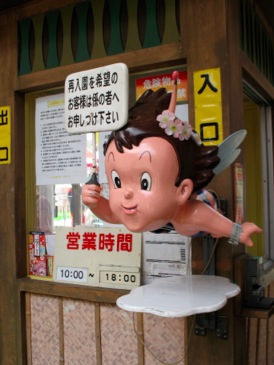
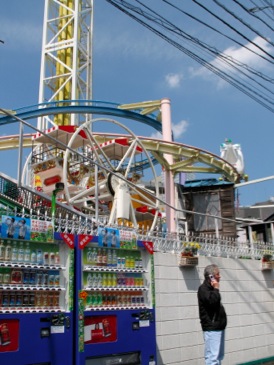 
Kappabashi, a short walk from
Tawaramachi on the Toei Ginza line, is a street lined with catering equipment shops. You can buy anything from handmade knives to custom noren, a sushi chef’s jacket or plastic food.
From the local pier you can take a spacecraft-like ferry that will take you down the river to Odaiba, the reclaimed island in Tokyo harbour. A smaller version of the statue of liberty awaits, along with modernist buildings, notably Fuji TV with its Van der Graaf generator-style viewing tower. Here you will also find themed bars, restaurants and gift shops for the manga generation, and Tokyo Big Sight, a conference and exhibition hall hosting many events all year round.
Yurikamome, the elevated train, leaves here back into the city over the rainbow bridge. Lit up at night, this bridge takes road traffic and trains on different levels and deposits you at Shimbashi station, where just behind, is the holy grail for those with a sweet tooth, Ogawaken, a Japanese patisserie baking in the French style, famous for their ‘raisinwich’, a buttery almond topped biscuit sandwich filled with air light buttercream and enormous raisins steeped in rum, about £5.00 a box, so popular that they sometimes run out. They also have a tea/coffee shop and you can enjoy their cakes here too.
Perhaps something more substantial for lunch, located in the same building, is a soba shop: home made soba and a good selection of sake, all of the best standard and freshness.
Art
The Japanese have a tradition going back centuries of the finest crafts and artworks, something that continues to this day. It can be seen for free in the specialist shops featuring wedding kimono of the very finest hand woven cloth. If you look hard, some quite extraordinary contemporary designs are available, but not for sale to the casual tourist, as they can cost into the millions of yen.
The same can be said of pottery, an ancient art originally imported from Korea and changed over the centuries to the Japanese way. There are mountains of ceramics, art pieces and tableware available cheaply and of great quality; a wonderful but heavy gift, if you get carried away.
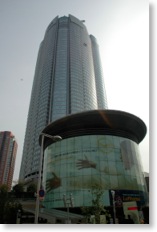
Modern art lives and flourishes here and one of the best places, a day out on its own, is the Mori art museum on the 53 rd floor of the Mori building in Roppongi Hills, with an English curator. It is the jewel in the crown. Always there seem to be great exhibitions on here and so much more. There is a viewing platform with 360º views of Tokyo day and night,
Art on the streets is brought by the younger generation in fashion form. What you see here filters down to Europe in some form or another. The Japanese can be extreme with their fashion; the only time in their lives when rebellion is OK, before filtering back into the homogeneous society .
Eating
All tastes are catered for here and the standards are high. There are food floors in the department stores; whole city blocks given over to a myriad of small specialist retailers from chocolate to chanko nabe, the sumo wrestlers’ dish.
The finest products from all over the world, Château Lafite jostling for position with the finest sake, Scottish wild smoked salmon or the melt in the mouth Toro fatty tuna.
It all harks back to the past; the cries of the shop assistants ring out over the marble halls decked with chandeliers all trying to get your custom. Apart from the environment nothing has changed over time. People eat here as it’s the national pastime; beer not sake is the beverage of choice, well represented by Asahi Kirin and many others .
If your first taste of sushi was a supermarket package of over chilled densely packed rice topped with a sliver of not so fresh fish underpinned by fiery virulent green wasabi, you are in for a major shock. It’s not like that at all. Kaiten sushi going round on a belt can be excellent, but owing to the price you will still get the powdered wasabi which is in fact colored horseradish and bears only a passing resemblance to the real thing, which is somewhat more subtle and refined; the fish will be a little thinner than bespoke sushi but very good value.
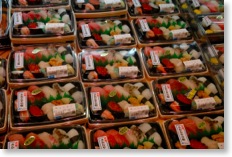
The real deal seldom comes cheap, but it is an experience you will savour forever. After waiting for your seat, finally you get a place at the counter, sushi chefs busy themselves with the constant flow of orders from the seated diners, placing perfectly crafted pieces of rice and fish directly onto to a lacquered surface, piling beside home made pickled ginger, originally there as an aid against bacteria, along with the vinegared rice. Initially used as a preservative, this would be stuffed into fish to help its preservation.
The rice is at room temperature, topped with your chosen fish or shellfish, which has been smeared on the underside with hand grated wasabi. The topping is cold, but not too chilled, allowing all the delicate flavours and textures to be at their best. This is dipped into shoyu (soy sauce) much more delicate and refined than what we generally find in the UK. Some sushi shops will soften the sauce with dashi (kelp and bonito stock) or paint the fish ready for eating and not offer shoyu.
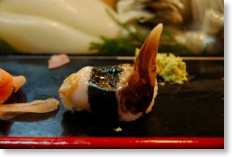
It is not always necessary to use chopsticks; using ones hands is quite acceptable. You will have been presented with a hot towel at the beginning of the meal or in the summer a chilled one; just wipe your hands on this.
The variety of fish and shellfish is enormous and seasonal, variation in price is usually upwards although some bargains are to be had if you like oily fish. Iwashi or sardine is fantastic. Small and bright, it is filleted and the membrane is removed leaving a silvery surface. It is topped with finely grated ginger and shredded negi (spring onion).
The undisputed favourite of the Japanese is Toro, the fatty belly of tuna, meltingly delicious. There is nothing to compare and it should be tried at least once at source in a lifetime.
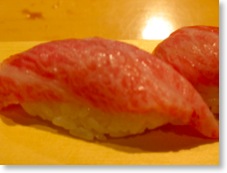
Where to find the best
Tsukiji market from 5am. Expect queues at the weekend. My favorite and now, it seems, everybody else’s is Daiwa (? Yamato?) identified by its brown on white noren and big queues. I have tried them all and this still reigns supreme; the best in Tsukiji, the best in the world…?
Sushi Bun still excellent, not so busy but well established. The adjacent streets feature a large market, labyrinth in style, featuring many sushi shops, including a 24 hour establishment, so if you are only here briefly there is no excuse not to indulge. Even when leaving Tokyo, the airport comes up trumps with a sushi shop which is excellent and reasonable; an oasis of calm in a busy airport.
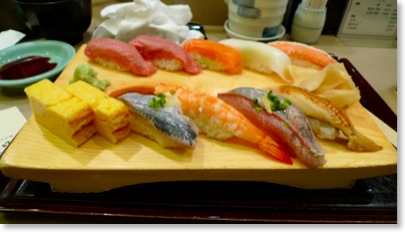
0 Comments
